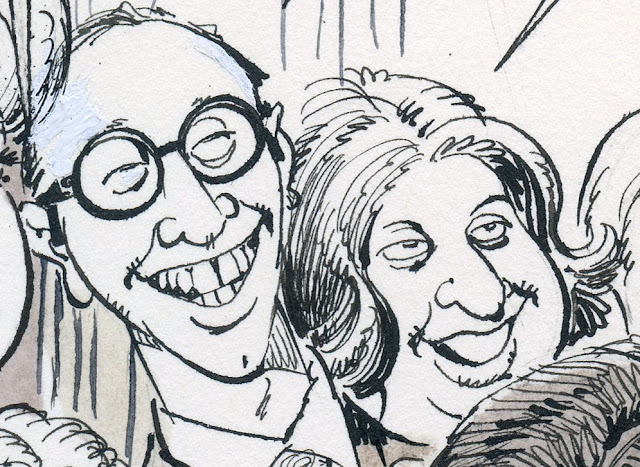There are 35 faces in this crowd. I always assumed Drucker kept the world's largest reference file of face photos:
But Drucker explained that these were "spontaneous faces" he made up as he went. I asked where the great variety came from and he answered, "I like to notice people's faces. Sometimes when I was on the subway or sitting outside the dressing room at Loehmann's waiting for my wife Barbara to try on a dress, I'd see an interesting face and say, "Hmmm, I can use that."
How do you make use of your time on the subway?
I don't know of another cartoonist today who pays such attention to the variety of the human face. To the contrary, as I've complained in the past, the trend seems to be toward generic, simplified faces with little content or individuality. This seems especially true of cartoonists and illustrators who pride themselves in their editorial content.
Talking with Drucker, I was struck by the pleasure he takes in the humanity of individual faces. That may be a difference between an artist who focuses on the human and artists who focuses on abstractions about humankind.










9 comments:
More Drucker!
It's interesting how the faces vary in style. Some are a bit realistic while other are cartoony, some look like he had a particular character in mind while other look more general. The image is quite dynamic. And even tho almost all of the faces are expressing the same basic emotion, all of them possess a different psychological variation. Ekman discovered that forty muscles under the human face (we have more facial muscles than primates) can perform ten thousand expressions. Drucker obviously enjoys this diversity his whole life and that image is a pleasant panorama of it.
MORAN-- Yes, he's one of my favorites.
Aleš wrote: "It's interesting how the faces vary in style. Some are a bit realistic while other are cartoony,"
I specifically asked Drucker about that. Some caricaturists such as Hirschfeld or Levine, who may do one or two faces per drawing worked in a very consistent style but Drucker, who might do 30 or 40 faces per drawing, often enjoyed using different treatments for different faces. It's not unusual for an artist to draw less important faces in a crowd with a lighter touch, but Drucker took it further. He said, "I liked to see how far I could push it and still hold the drawing together." He would do a very simplified or extreme cartoony face talking to a natural looking face, or draw a two dimensional cartoon figure over a realistic background, and use the lines and composition to glue the picture together.
Yes, in the hands of a lesser artist all those diversities would look like they don't belong together. And it shows that Drucker doesn't seem to have a specific model of the head that would always serve as a foundation. He just grows something new every time. That kind of creative freedom enables vitality that is very rare.
Thank you for this post. I was an avid reader of MAD back in the day and Mort was my idol. I was never so flattered as when my caricatures were compared to his.
As pointed as his observations are, you get the sense that Drucker liked people and was fascinated by their infinite variety. There are no ugly people in a Drucker bestiary, just interesting specimens. Compare to his co-illustrator at MAD Magazine, George Woodbridge, who made some of his victims hilariously awful.
Love your blog, and this is a typically great analysis, but you missed a detail-- and it seems Drucker forgot his own in-joke as well.
Despite his comment that these were a group of "spontaneous faces" he made up as he went, Drucker frequently put real people in "cameos" in his crowd scenes, and a couple appear here.
The man on the left that you featured in closeup in the fifth image is almost certainly Neil Simon, who wrote the screenplay for "The Heartbreak Kid"-- same hairstyle, same glasses as in early '70s photos of Simon:
http://en.wikipedia.org/wiki/Neil_Simon#/media/File:Neil_Simon_-_1974.jpg
But the woman with the glasses and hat who gets a closeup in your second image is absolutely Elaine May, who not only directed "The Heartbreak Kid," but is the mother of Jeannie Berlin, who plays the bride "Lulu"/Lila.
In fact, Drucker's caricature of May is photo-referenced straight from the poster for her writer/director/star venture of the year previous, "A New Leaf":
http://en.wikipedia.org/wiki/A_New_Leaf_(film)#/media/File:A_New_Leaf.jpg
Aleš-- I agree, and that's one of the things I enjoy most about Drucker. he doesn't start with a template for the human head, like every other cartoonist on the planet. Even in crowd scenes, most of the heads are re-invented from scratch.
Anonymous wrote: "you get the sense that Drucker liked people and was fascinated by their infinite variety. There are no ugly people in a Drucker bestiary, just interesting specimens"
Drucker commented on that specific point. He said he didn't believe in being cruel in his caricatures: "Just because someone has a big nose, you don't have to play that up and be mean about it." His tender heartedness must have been a handicap in creating a likeness but it was one he was perfectly content to carry.
hsc-- Great catch on the faces of Elaine May and Neil Simon, who I didn't recognize. It turns out that Simon had an uncredited role as an extra in the wedding scene. Can you imagine drawing all those faces and throwing in some extra caricatures for an in joke that almost no one would get? I'm glad that we are here, 44 years later, picking up on Drucker's little jokes. It makes his extra effort worthwhile. Thanks!
I just enjoyed HEARTBREAK KID actress Jeannie Berlin as the cynical, seen-it-all-and-tired-of-it prosecutor on the HBO limited series "The Night Of." I didn't even know she was still acting.
Thanks for sharing this kind of art. I really love it.
Post a Comment